#One of the earliest known dinosaurs
Text

Skytober Day 9 Moth (Eoraptor)
My other Skytober drawings
#sky cotl#sky children of the light#thatskygame#sky but with dinosaurs#skytober 2023#A moth fresh off the press and the perfect dinosaur to accompany them#Eoraptor#One of the earliest known dinosaurs#I know there’s other ones that are possibly earlier but this one is cute#I never realized how morning in home space looked until I had to color this#Very brown? Grey? Idk#Still trying to catch up#I might just draw the ones that interest me more and then circle back#To previous days when I finally get an idea#Also just noticed I’ve colored the past 3 dinosaurs brownish. Gotta fix that lol
187 notes
·
View notes
Text
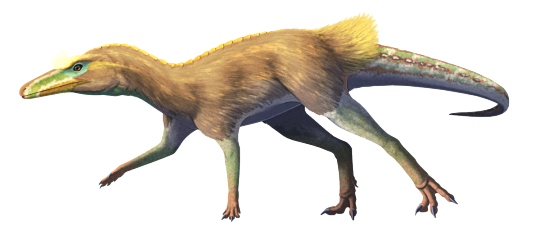
Last week I mentioned the one oddball dinosauriform that had crocodilian-like osteoderm armor, so let's take a look at that one too.
Lewisuchus admixtus lived in what is now northwest Argentina during the late Triassic, around 236-234 million years ago. About 1m long (3'3"), it was an early member of the silesaurids – a group of dinosauriforms that weren't quite dinosaurs themselves, but were very closely related to the earliest true dinosaurs.
(They've also been proposed as instead being early ornithisichians, but we're not getting into that today.)
Much like its later silesaurid relatives Lewisuchus had a long neck and slender limbs, and was probably mainly quadrupedal, possibly with the ability to briefly run bipedally to escape from threats. Its serrated teeth suggest it was carnivorous, likely feeding on both smaller vertebrates and the abundant insects found in the same fossil beds.
Uniquely for an early dinosauriform it also had a single row of bony osteoderms running along its spine. Although it lived at close to the same time as the similarly-armored Mambachiton their last common ancestor was at least 10 million years earlier, and no other early dinosaur precursors with osteoderms are currently known – so this was probably a case of Lewisuchus independently re-evolving the same sort of feature.
—
NixIllustration.com | Tumblr | Patreon
#science illustration#paleontology#paleoart#palaeoblr#lewisuchus#silesauridae#dinosauriformes#avemetatarsalia#archosaur#reptile#art#the early ornithischian idea is intriguing BUT it's also being pushed by the ornithoscelida gang#so that's a thing#(...i should probably also talk about the state of ornithoscelida at some point; it's been what almost seven years?)#(short version: we still dunno and early dinosaur relationships resolve in multiple equally-likely ways; More Data Is Needed)
522 notes
·
View notes
Text
ITS ALMOST FOSSIL NOVEMBIRB!!!!!
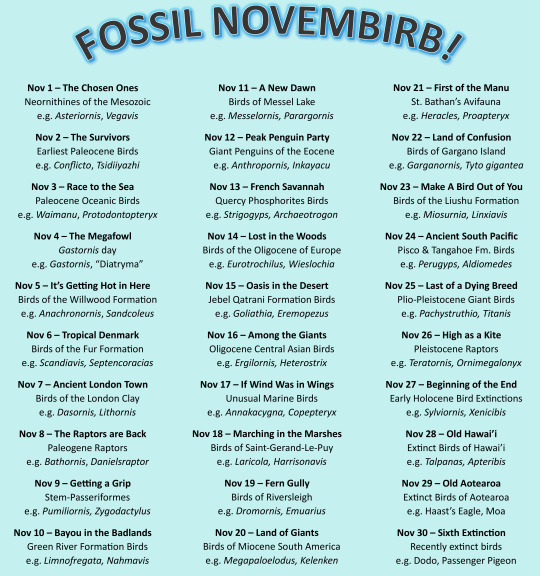
We're going to have a CELEBRATION of FOSSIL NEORNITHINES for this November!!! The extinct members of the only group of dinosaurs we have today!
Each day will have a prompt inspired by the evolution of crown-birds and the amazing forms they have taken over the past 68 million years!
You can respond to each day's prompt however you wish - with drawing and painting, writing, sculpting, music, videos, whatever! Just tag it "#Fossil Novembirb" for me to find it, and it'll get reblogged!
I'm so excited to see the art you guys create!
NOVEMBER 1 - THE CHOSEN ONES
Crown-Birds (Neornithes) known from the Mesozoic Era!
Options include Asteriornis, Teviornis, Vegavis, and "Styginetta"!
These are the only dinosaurs that survived the asteroid!
Theoretically there were also early Palaeognaths and Neoavians - if you want to do some spec evo and hypothesize what you think they might have looked like, go ahead! Follow your dreams!
NOVEMBER 2 - THE SURVIVORS
The earliest birds known after the K-Pg boundary!
Options include Conflicto, Tsidiiyazhi, Australornis, Qinornis, and Qianshanornis!
Birds diverged rapidly after the extinction, so also feel free to dive into spec evo into some of the forms we don't have fossils of!
NOVEMBER 3 - RACE TO THE SEA
The first Marine Neornithines and how they evolved in the early Paleocene!
Includes tons of early penguins like Waimanu, Kumimanu, Sequiwaimanu, Muriwaimanu, and Kupoupou
Also includes the first Pseudo-toothed bird, Protodontopteryx, and the earliest known Tropicbird, Clymenoptilon!
RISE OF THE PENGUINS!
NOVEMBER 4 - THE MEGAFOWL
Gastornis (aka "Diatryma", aka "Zhongyuanus") appeared in the mid-Paleocene and was a feature of the Cenozoic landscape until the end of the Eocene - so we have a whole day JUST FOR IT
Show your love for the Megafowl Gastornis! This giant herbivorous bird was fascinating, and has captured imaginations for decades because of it!
Gastornis is also present in many of the ecosystems described below, such as Willwood, Green River, and Messel, so we also just wanted to make sure people didn't keep picking Gastornis over and over again xD
NOVEMBER 5 - IT'S GETTING HOT IN HERE
The Paleocene-Eocene Thermal Maximum was the most dramatic incident of rapid global warming in the world since the Permian... until today!
It majorly affected the evolution of many things, possibly including birds!
The Willwood Formation straddles the time period of the warming, and has tons of birds that were evolving during that time period! So, for this day, create things involving birds of the Willwood Formation!
Options include the flighted Palaeognaths Lithornis promiscuus and Lithornis plebius; the possible stem-Ostrich Paragrus, the early half-screamer-half-duck Anachronornis, the early owl Primoptynx, and the fascinating stem-mousebird Sandcoleus! And many more!
NOVEMBER 6 - TROPICAL DENMARK
Birds of the Fur Formation, one of the best collections of bird fossils from the early Eocene!
Includes such friends as Scandiavis (an early shorebird), Septencoracias (an early roller), Pellornis (an early rail-esque thing), the utterly mysterious Morsoravis, and the early swift-hummingbird Eocypselus!
This was a tropical shoreline environment with many of the first members of major bird groups we see today!
NOVEMBER 7 - ANCIENT LONDON TOWN
Across the shore from Fur was the London Clay Formation, a lush tropical forest near the warm shallow ocean
In addition to a truly alarming quantity of plant fossils, this is a notable locality for early birds, featuring many early members of major groups much like the Fur Formation
Options include Dasornis (a pseudotoothed bird), Pulchrapollia (one of the Parrot-Passerines of Prey), Nettapterornis (another stem-duck), Nasidytes (an early loon), Charadriisimilis (an early shorebird), Archaeodromus (a trogon-like member of Strisores), Eotrogon (an actual early Trogon), Lithornis vulturinus (another flighted Palaeognath), Prophaethon (another early Tropicbird), and Ypresiglaux (an early owl) - and so many more!
NOVEMBER 8 - THE RAPTORS ARE BACK
Turns out "Predatory Feathered Thing with Really Sharp Foot Claws" is a very successful niche - not only was there potentially one right after the end of the Cretaceous (Qianshanornis), but other raptors were some of the first birds to succeed around the world in the Eocene
So this day is dedicated to the early raptors of the Cenozoic!
Any "raptor" from the Paleogene is valid - so here are some suggestions:
Early Cariamiformes (Seriemas and Kin) like Bathornis, Dynamopterus, Strigogyps, and the first potential Terror Birds like Paleopsilopterus
Early Owls like Ypresiglaux and Palaeoglaux
Early Accipitriformes like Horusornis
Early Falcons like Antarctoboenus, Masillaraptor, and Danielsraptor
And of course the ever popular "Parrot-Passerines of Prey" like Tynskya and Messelastur
NOVEMBER 9 - GETTING A GRIP
Half of all living birds are Passeriformes - aka "Perching Birds" - but this wasn't always the case! For most of Earth's history, many other kinds of tree birds were extremely common
Where did this behemoth group of tiny dinosaurs come from? That's the subject of this day's prompt!
In the Eocene, the first birds closer to Passeriformes than to Parrots evolved, and they came in a huge variety of forms! So on Nov 9th, we're going to celebrate this group's interesting beginnings!
Options for this include Parapsittacopes, Eofringillirostrum, Pumiliornis, Psittacopes, Zygodactylus, Primozygodactylus, Psittacomimus, Sororavis, Morsoravis, and Eozygodactylus! Go wild!
NOVEMBER 10 - BAYOU IN THE BADLANDS
Back to specific ecosystems! We're visiting the world-famous Fossil Lake of the Green River Formation!
This environment, during the Early Eocene, was a thriving tropical lake and forest ecosystem filled with tons of early Neornithines as well as mammals and other animals
Gorgeous fossils have come out of this lake, showing truly amazing detail of feathers and other features for these birds!
So here you can feature Prefica (a potential early Oilbird), the flighted Palaeognath Calciavis, the stem-turaco Foro, the early mousebird Celericolius, the possible shore-bird Nahmavis, a potential cuckoo roller Plesiocathartes, the Flamingo-Duck Presbyornis, the early landfowl Gallinuloides, the swift-hummingbird Eocypselus, and the Frigate Bird Trying at being a Gull Limnofregata - and so many more!
NOVEMBER 11 - A NEW DAWN
We're finally moving on to the middle Eocene - and the Messel Lake ecosystem, famous from the first episode of Walking with Beasts (hence the name of the day)!
(If you're going "wait, that episode acts like nothing happened between the K-Pg and Messel, but here you have 10 days worth of stuff" .... yeah. Walking With Beasts skipped the Paleocene and early Eocene and I am... very pissed. Still.)
You know about the tons of early mammals from this tropical lake ecosystem, but it was filled with tons of early birds as well!
There's the early ostrich Palaeotis, the crane-rail Messelornis, the almost-flamingo Juncitarsus, the freshwater Booby Masillastega, the early hoopoe Messelirrisor, Selmes (a mouse bird with stubby toes), the early ibis Rhynchaeites, the early nightbird Hassiavis, the early swift Scaniacypselus, an early roller with known colors Eocoracias, and the early potoo Paraprefica - and many others!
NOVEMBER 12 - PEAK PENGUIN PARTY
As the Eocene continued, penguins achieved true megafaunal status - there were tons of them, they were huge, and they were all over the oceans of the Southern Hemisphere
While penguin diversity never did recover after the Eocene-Oligocene extinction event, this golden age deserves celebration!
Some of these fascinating peak penguins include Palaeeudyptes, Anthropornis, Icadyptes, Inkayacu, Perudyptes, and Kairuku!
NOVEMBER 13 - FRENCH SAVANNAH
As the Eocene began to dry up and cool down, plains grew across the world where the tropical forests once had been
One of the most famous later-Eocene fossil sites for birds is the Quercy Phosphorites location, a French formation with tons of interesting fossil birds!
Here we start to see the early forms of Neornithine Dinosaurs we saw in the Paleocene-Early Eocene diverge and specialize further - often in particularly weird or interesting ways!
So here we have the duck-ish chicken Paraortyx, the secretarybird Pelargopappus, you can also bring back Dynamopterus from earlier, there is the stem-chicken Quercymegapodius as well as stem-parrots like Quercypsitta, the seriema-like Strigogyps, the sandgrouse relative Archaeoganga, Archaeotrogon shows up again, the swift relative Aegialornis, a potential woodpecker relative Sylphornis, and more owls like Palaeoglaux! Lots of cursorial predators in this ecosystem!
NOVEMBER 14 - LOST IN THE WOODS
As the Oligocene dawned, forests did grow back in Europe, though they were now temperate and dry as opposed to the paratropical rainforests of before
This lead to wide diversification of tree-dwelling birds, and so here we will celebrate the birds of the Oligocene of Europe!
We start to really see modern-esque birds at this point, though of course we still have 30 million years of evolution to go!
Here you can feature the early eagle/hawk Aviraptor, the European Hummingbird Eurotrochilus, the seabird relative Rupelornis, the early woodpecker-toucan Rupelramphastoides, the tody Palaeotodus, the proper Passerine Wieslochia, the possible shorebird Turnipax, the mousebird Oligocolius, the hoopoe Laurillardia, and the trogon Primotrogon which we know the colors of!
NOVEMBER 15 - OASIS IN THE DESERT
The Jebel Qatrani Formation of Egypt shows the beginnings of the famous African Grassland animals, as well as many early members of iconic African animal groups such as primates - and, of course, birds!
Taking place in the early Oligocene, this formation was a tropical/subtropical lowland plain filled with ponds and streams and other waterways - aka, tons of swamps surrounded by plains
As such, this place is infested with waterbirds!
Here we have a fossil relative of the Shoebill Goliathia, as well as the jacanas Janipes and Nupharanassa, the giant stork Palaeoephippiorhynchus, the herons Nycticorax and Xenerodiops, and the mystery Palaeognath Eremopezus!
NOVEMBER 16 - AMONG THE GIANTS
Once again we're just fully committing to the Walking With Beasts nostalgia bc these are the birds we wish were in it more okay we said it
Anyways there were some interesting large birds in the plains of the "Land of Giants" episode so picture these guys alongside the Indricothere etc.
In general we're covering the latest Eocene through the Oligocene of Central Asia
Here we have the enigmatic ratites Ergilornis and Sonogrus, the pseudo-toothed bird Caspiodontornis, the owl Heterostrix, and the stem-flamingo Agnopterus
NOVEMBER 17 - IF THE WIND WAS IN OUR WINGS
We all focus on penguins, but over the Cenozoic, plenty of weird birds have evolved for marine life, and boy are they bizarre!
So for Nov 17, we're focusing on the unusual marine birds of the Cenozoic!
This includes any members of the Pelagornithids - aka the Pseudo-toothed birds - as well as the Plotopterids - the Boobies that became Penguins! Pelagornis and Copepteryx are the best known taxa from each, respectively, but there are plenty more!
But that's not all! We have the flightless auks Miomancalla and Mancalla, the large flightless marine duck Chendytes, and who can forget the weird flightless marine swan Annakacygna! Tons of options to choose from!
NOVEMBER 18 - MARCHING IN THE MARSHES
We're now starting our transition from the Paleogene into the Neogene, beginning with the brackish marsh ecosystem preserved at Saint-Gerand-Le-Puy in France!
This Miocene locality preserves a wide variety of birds that are near modern, but not quite - a sort of "uncanny valley" of bird evolution, all set in a somewhat-salty somewhat-not wetland ecosystem
Options for dinosaurs here include Harrisonavis, a transitional flamingo; the early gull/tern Laricola, the enigmatic duck Mionetta, the stork Grallavis, the pratincole Becassius, the swimming-flamingo Palaelodus, the early cormorant Nectornis, the seed-eating pheasant Palaeortyx, the early loon Colymboides, and the mysterious shorebird Elorius!
NOVEMBER 19 - FERN GULLY
Riversleigh is one of the most famous fossil sites in the world, preserving the evolution of the strange and unique animals known today in Australia, during the Oligocene to Miocene transition
Most often, we focus on the bizarre mammals found at Riversleigh, and for good reason - it's a Marsupial Party! - but the birds here are fantastic as well
This ecosystem was a rich rainforest that transitioned over the period of deposition into a semiarid grassland, and covers 20 million years of animal evolution during that transition
Options for birds here include the butcherbird Kurrartapu, the fossil Sittella Daphoenositta trevorworthyi, the Mihirungs ("Demon Ducks") Dromornis and Barawertornis, the Emuwary Emuarius, the early magpie-goose Eoanseranas, the raptor Pengana with flexible ankles, the earliest known species of lyrebird (Menura tyawanoides), the corvid-like Corvitalusoides, the first known cockatoos, the flightless rail-like bird Australlus, the stiff-tailed duck Pinpanetta, the early logrunner Orthonyx kaldowinyeri, and so many more!
NOVEMBER 20 - LAND OF GIANTS
Y'all were probably wondering when we'd get to the Terror Birds and other interesting dinosaurs of South America, so - here we are!
South America, isolated from the rest of the world until the Great American Interchange, featured a wide variety of bizarre and unique animals - not just mammals, but birds and other reptiles as well!
So for Nov 20th, we're looking at the interesting dinosaurs of the "lost continent" during the Miocene epoch, prior to the invasion of North American taxa!
Any Miocene South American Terror Bird (Phorusrachid) is fair game here, so that includes Brontornis, Patagorhacos, Paraphysornis, Devincenzia, Kelenken, Phorusrhacos, Patagornis, Andalgalornis, Psilopterus, Mesembriornis, and Procariama! Note that they did not all live at the same time or even close to each other in location, so do your research on the taxa you pick!
But Terror Birds weren't the only strange dinosaurs in South America at the time! We have the large Teratorn (vulture-like-thing) Argentavis, the *giant* swimming-flamingo Megapaloelodus, the giant Anhinga Macranhinga, the rhea Opisthodactylus, the penguins Palaeospheniscus, Arthrodytes, and Paraptenodytes, the Cathartid Dryornis, the Jacamar Galbula hylochoreutes, fossil Hoatzins like Hoazinavis and Hoazinoides, the giant stork Leptoptilos patagonicus, and the owl Yarquen!
NOVEMBER 21 - FIRST OF THE MANU
Aotearoa has one of the most unique avifaunas in the world today, and I often call it "Mesozoic 2" because of its almost entirely dinosaur-dominated fauna, especially in the past
All great things have to start somewhere or when, and for Aotearoa, that somewhen was after the landmass resurfaced from the ocean for the first time in millions of years - and was quickly inhabited by all kinds of birds and other reptiles (including tuatara) in the Miocene
This ecosystem was a lake bordered by grassy wetland floodplains and subtropical forests, a bit warmer than Aotearoa today
Dinosaurs here include the early Kiwi Proapteryx, an unnamed early Moa, a truly alarming number of waterfowl including shelducks like Miotadorna, stiff-tailed ducks like Manuherikia, and the possible swan Notochen, the small swimming-flamingo Palaelodus aotearoa, pigeons like Rupephaps and Deliaphaps, an early adzebill Aptornis proasciarostratus, flightless rails like Priscaweka, the lake-wanderer Hakawai melvillei, the herons Pikaihao and Matuku, the giant parrot Heracles, proto-keas Nelepsittacus, and the New Zealand Wren Kuiornis. Tons of fun species to choose from!
NOVEMBER 22 - LAND OF CONFUSION
In the Late Miocene to Early Pliocene, the Italian province of Gargano was cut off from the mainland due to rising sea levels, turning it into an island - an island with lots of really strange birds!
This island was cut off from everything else and completely lacked large predators, allowing for a weird variety of animals to evolve and thrive prior to the island rejoining the mainland during the Ice Age
Strange birds of this ecosystem include the extremely old pigeon Columba omnisanctorum, the giant hawk Garganoaetus, the giant flightless goose Garganornis, the giant barn owl Tyto gigantea, the pheasant Palaeortyx volans, and the swift Apus wetmorei!
NOVEMBER 23 - MAKE A BIRD OUT OF YOU
The iconic animals of the Ice Age and recent prehistory had to come from somewhere, and much of this transition is recorded in the Chinese Ecosystem of the Liushu Formation, deposited between 11 and 6.4 million years ago
As grasslands expanded, this ecosystem transitioned from a forest to a wide plains, and many animals adapted for the grasslands accordingly, leading to the appearance of such mammals as Elasmotheriines, Sabercats, Hyenas, Ambelodonts, and a truly alarming quantity of hoofed mammals
Dinosaurs (Birds) adapted to this ecosystem change as well, of course! While most focus on the mammals of Liushu, we're here to showcase the interesting birds that appeared here as well!
Options here include the the very well preserved Falcon Falco hezhengensis, the vultures Mioneophron and Gansugyps, the diurnal owl Miosurnia, the vocally fancy pheasant Panraogallus, the sandgrouse Linxiavis, the Ostrich Struthio (or Orientornis) linxiaensis, and the probable-Ostrich Sinoergilornis
NOVEMBER 24 - ANCIENT SOUTH PACIFIC
Penguins are Bouncing Back! As the Miocene continued and the Pliocene began, many new types of marine birds showed up and were fossilized in locations in Chile (Pisco) and Aotearoa (Tangahoe)
Tons of interesting birds were preserved in this sort of transitional ecosystem, showcasing how birds adapted to changing conditions as the Miocene-Pliocene climatic turmoil continued
These near shore environments are probably more famous for their other animals - things like the giant shark "megalodon", as well as weird whales like Livyatan and Odobenocetops and aquatic giant sloths (like Thalassocnus) and marine crocodilians - but we're here for those dinosaurs!
Options here from the Pisco Formation include the "Toucan-Booby" Ramphastosula, the Cathartid Perugyps, the Booby Sula figueroae, Pelagornithids, Pelicans, and the penguins Spheniscus urbinai and Spheniscus megaramphus, whereas birds from the Tangahoe Formation include the narrow-beaked albatross Aldiomedes, the giant petrel Macronectes, the more regular-sized petrel Procellaria altirostris, the little penguin Eudyptula wilsonae, and the crested penguin Eudyptes atatu!
NOVEMBER 25 - LAST OF A DYING BREED
We all love Megafuana, even though they are usually the "Live Fast Die Young" kind of species - gobbling up resources and growing too big will do that to you
Usually when we hear the term "Megafauna" we think of Mammals and Non-Avian Dinosaurs, but birds have had their share too - and have lost their share as well
So, mainly to cater to the Megafauna Fanbase, here we dedicate a whole day to the giant birds of recent times - Pliocene through Pleistocene - that we have lost to the dramatic climate change of the Ice Age Era. (Those lost in the Holocene will get their own days, see below)
Options for this day include the giant ostrich Pachystruthio, the Mihirung Genyornis, the Terror Bird Titanis, the giant stork Leptoptilos robustus, the giant swan Cygnus falconeri, the giant Anhinga Giganhinga, and of course - we can't forget our friend - the last of the Pseudotoothed Birds, Pelagornis
NOVEMBER 26 - HIGH AS A KITE
In many ways, the real dinosaur winners of the Ice Age were the flying Birds of Prey, as there were many kinds of raptors during the Ice Age and they exploited the new environment expertly
Nothing like being able to traverse huge distances to find places where there are food, amiright?
So this day is dedicated to the fantastic Raptors of the Ice Age, both volant and not!
Here we have some of the last of the Teratorns like Teratornis itself, the Giant Australian Raptor Dynatoaetus, the Australian Vulture Cryptogyps, Woodward's Eagle Buteogallus woodwardi, the tiny Condor Wingegyps, the large Cuban Eagle Gigantohierax, the wandering vulture Neogyps, the Walking Eagle Buteogallus daggetti, the Giant Cuban Stilt-Owl Ornimegalonyx, and one of the last Terror Birds, Psilopterus
NOVEMBER 27 - BEGINNING OF THE END
Oh Holocene Extinctions. As upsetting as they are, they include some of the best known fossil/subfossil birds, so we decided to spend a little extra time on them than they should have based solely on the time length
Here, we highlight the early losses of the Holocene - those dinosaurs that went extinct at the start, largely due to direct human activity such as hunting in addition to the warming caused by the end of the last Ice Age/Glacial Maximum
Days will be dedicated to both Hawai'i (see below) and Aotearoa (again, below), so this is for everyone else!
So options here include the previously mentioned marine duck Chendytes, the giant flightless landfowl Sylviornis from New Caledonia, the famous Elephant Birds of Madagascar, the flightless clubbing-ibis Xenicibis, the weird puffin Fratercula dowi, the giant Bahama Eagle Titanohierax, the Californian Turkey Meleagris californica, and the flightless "Cave Rail" Nesotrochis of the Greater Antilles
NOVEMBER 28 - OLD HAWAI'I
Many, many, MANY unique dinosaurs live on islands. The islands of Hawai'i are no exception, and these islands have lost many unique and fascinating birds over the years - thanks to human activity, invasive cats, colonialism, and climate change
We couldn't possibly ignore them, so for this day, we are hilghlighting these amazing animals found across the archipelago
There are tons of options, but some of our recommendations include the reverse-platypus/Mole Duck Talpanas, the Stilt-Owl Grallistrix, the flightless ibis Apteribis, the Moa-Nalo like Chelychelynechen, Ptaiochen, and Thambetochen, the Wood Harrier Circus dossenus, Hawai'ian Honeycreepers like Drepanis, Aidemedia, Hemignathus, Chloridops, Akialoa, Rhodacanthis, Dysmorodrepanis, Telespiza, and Vangulifer, the Oloma'o and ʻĀmaui thrushes, ʻōʻō's/Hawai'ian Honeyeaters like the Kioea, Kauaʻi ʻōʻō, and Oʻahu ʻōʻō, the giant Hawai'i Goose, the nēnē-nui/wood-walking goose, the Robust Crow, the flightless Laysan Rail, and the O'ahu Petrel
NOVEMBER 29 - OLD AOTEAROA
We're finally here: Pre-Human Holocene Aotearoa, aka Mesozoic 2, aka The Land Where Mammals Ain't Shit
I love Aotearoa so much. Why wasn't I born there. The universe isn't fair.
The ecosystems were very similar to today - podocarp forests and southern beech forests, grass and tussock plains and shrublands, and plenty of coastal habitats, all usually temperate in terms of climate
All named Moa are fair game. All of them, all named members of Dinornithiformes. So the North Island Giant Moa, the South Island Giant Moa, the Bush Moa, the Eastern Moa, the Broad-Billed Moa, the Heavy-Footed Moa, Mantell's Moa, the Crested Moa, and the Upload Moa. Follow your Moa-Filled Dreams!
Obviously there were more than Moa - not just the living species of Aotearoa still with us, but tons of other extinct forms for Fossil Novembirb. This includes the Adzebills, Haast's Eagle (of course), the whēkau/Laughing Owl Ninox albifacies, the New Zealand Goose Cnemiornis, the New Zealand Owlet-Nightjar, the mehonui Diaphorapteryx, the Long-Billed Wren Dendroscansor, the piopio Turnagra, and the Huia
NOVEMBER 30 - SIXTH EXTINCTION
And, for our last day, we cover recent Holocene extinctions (not on Hawai'i or Aotearoa) - the birds/dinosaurs we have lost in the living past, due largely to colonialism, capitalism, globalism, and climate change
Any bird extinct since 1492 not previously covered is fair game, and there are a lot of them. Today, we honor them, however we can.
Some suggestions include the Dodo (of course), the Cuban Macaw, the Pink-Headed Duck, the Northern Curlew, the Great Auk, the Passenger Pigeon, the Carolina Parakeet, the Ivory-Billed Woodpecker, the Labrador Duck, the Saint Helena Hoopoe, and the Spectacled Cormorant; though there are of course many otherse to choose from as well
Kind of a bummer note to end on, but here we are
Living Birds already get tons of time and attention, so we really don't want to include them here - we love them, but the fossils of the Neornithes world deserve love too! So we tried to cover all of the bases, as best as we could!
Remember, Wikipedia, the Paleobiology Database, The Works of Gerald Mayr, the third volume of "Earth Before Us", and the blogs of myself and @albertonykus and @otussketching are all fantastic resources to look for information about these wonderful animals! Also check out Through Time and Clades' "Dinosaurs: The Second Chapter" series and the Raptormaniacs blog from Albert as well!
HAVE FUN! CREATE WHAT YOU DREAM! AND LOVE CENOZOIC DINOSAURS!
HAPPY FOSSIL NOVEMBIRB!
#Fossil Novembirb#Novembirb#Dinovember#birblr#palaeoblr#Birds#Dinosaurs#Cenozoic Birds#Neornithines#Dinovembirb
613 notes
·
View notes
Text
Fossil Novembirb: Day 8 - Raptors Are Back

Once the Cenozoic had begun, the only remaining dinosaurs were modern birds. That means raptors (or dromaeosaurs) would never again stalk the Earth, right? Wrong! Raptor dinosaurs get their name from modern raptors: eagles, hawks, owls and the like; and they are in fact some of the closest relatives of birds. So during the Paleogene period when predatory birds started to radiate, they weren't reinventing being a raptor. They continued being raptors.
Palaeoglaux: An early owl from Germany's Messel Lake, about 40 million years ago. Unlike modern owls, it had strange ribbon-like feathers on its body, likely used in display.
Horusornis: A strange relative of hawks and eagles that lived in France 35 million years ago. Like modern harrier-hawks, it had flexible feet to dig out prey from tree cavities.
Antarctoboenus: An early relative of falcons found from Antarctica, about 35 million years ago. It may have prowled near the edges of giant penguin colonies.
Danielsraptor: Another early falcon from the 50 million year old London Clay formation. It had a large jagged beak and long legs, which helped it catch prey on the ground.
Dynamopterus: A relative of Seriemas and terror birds from Messel lake, about 40 million years ago. It likely caught small vertebrates from the forest floor.
Paleopsilopterus: One of the earliest known terror birds, it lived in Brazil about 50 million years ago. It was already flightless and similar to later small terror birds.
Bathornis: A distant relative of terror birds that was remarkably successful. This flightless predator and its relatives lived in North America from the Late Eocene to the Oligocene.
Messelastur: A falcon-like bird of prey that was closely related to parrots and passerines instead of raptors. It lived in Messel Lake about 40 million years ago.
Masillaraptor: A tiny true falcon also known from Messel Lake. It had a relatively long beak from a falcon, and it may have fed mostly on large insects.
Tynskya: Another small raptor related to parrots and passerines, this falcon-like predator lived around 50 million years ago. Its remains have been found in North America and Europe.
#Fossil Novembirb#Novembirb#Dinovember#birblr#palaeoblr#Birds#Dinosaurs#Cenozoic Birds#Palaeoglaux#Horusornis#Antarctoboenus#Danielsraptor#Dynamopterus#Paleopsilopterus#Bathornis#Messelastur#Masillaraptor#Tynskya
76 notes
·
View notes
Text
Ampelognathus coheni Tykoski et al., 2023 (new genus and species)
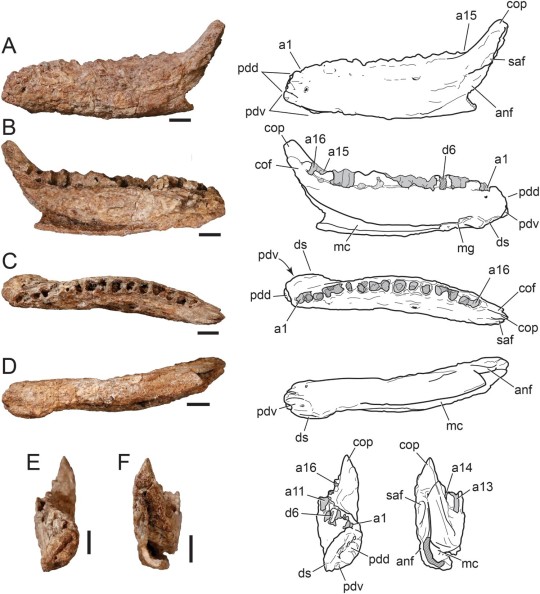
(Type jaw of Ampelognathus coheni [scale bars = 5 mm], from Tykoski et al., 2023)
Meaning of name: Ampelognathus = grapevine jaw [in Greek, referring to its discovery in the emergency spillway for Grapevine Lake]; coheni = for Murray Cohen [discoverer of the original fossil]
Age: Late Cretaceous (Cenomanian), around 96 million years ago
Where found: Lewisville Formation, Texas, U.S.A.
How much is known: The left half of a partial lower jaw.
Notes: Ampelognathus was an ornithopod, a diverse group of plant-eating dinosaurs that includes the duck-billed hadrosaurids. Although hadrosaurids included the largest known ornithischian ("bird-hipped") dinosaurs and probably spent most of their time on all fours, the earliest ornithopods were small, bipedal forms, and it was probably this ancestral body plan that was retained by Ampelognathus.
Ampelognathus is the first small ornithopod and one of the few ornithischians known from the Lewisville Formation. Its lower jaw was generally similar to that of other small ornithopods, but differs from theirs in several features, such as being slightly twisted along its length so that the teeth in the back of the jaw pointed somewhat inward.
Reference: Tykoski, R.S., D.L. Contreras, and C. Noto. 2023. The first small-bodied ornithopod dinosaur from the Lewisville Formation (middle Cenomanian) of Texas. Journal of Vertebrate Paleontology advance online publication. doi: 10.1080/02724634.2023.2257238
64 notes
·
View notes
Text
Coelophysis

Coelophysis is a genus of coelophysid theropod dinosaur that lived in the Late Triassic of what is now the southwestern United States. It is one of the earliest known dinosaur genera. It was a small, slenderly-built, ground-dwelling, bipedal carnivore that measured up to 3 m in length. Its weight is estimated between 15 and 25 kg. Despite being an early dinosaur, the evolution of the theropod body form had already advanced greatly compared to its contempories. In 1947, a substantial 'graveyard' of Coelophysis fossils was found in New Mexico. These specimens were numerous, including many well-preserved and fully articulated specimens.
69 notes
·
View notes
Text

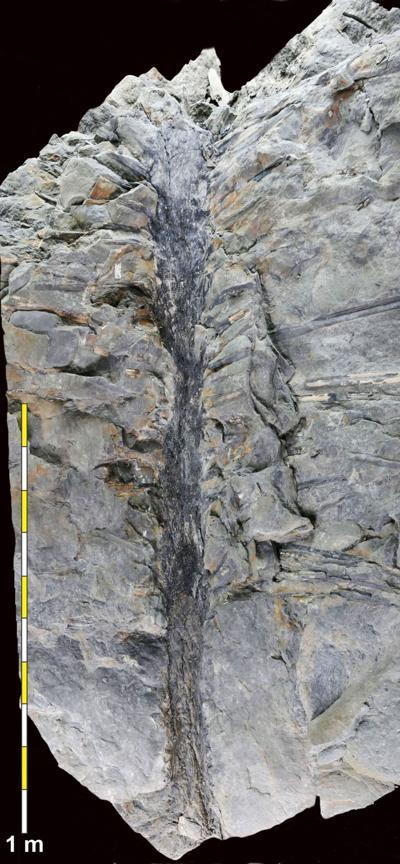
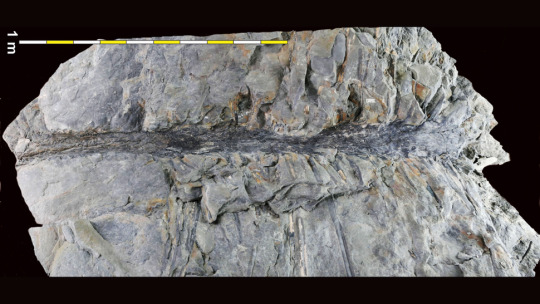
Rare 350 Million-Year-Old Tree Fossils Has Scientists ‘Gobsmacked’
Rare tree fossils preserved with their leaves have an architecture unlike any plant known today and represent the earliest evidence of smaller trees growing beneath the forest canopy.
Trees are believed to have originated hundreds of millions of years ago. Ever since, evidence of these ancient plant sentinels has been in short supply.
Now, a new discovery of uniquely 3D tree fossils has opened a window into what the world was like when the planet’s early forests were beginning to evolve, expanding our understanding of the architecture of trees throughout Earth’s history.
Five tree fossils buried alive by an earthquake 350 million years ago were found in a quarry in the Canadian province of New Brunswick, according to a study published Friday in the journal Current Biology. The authors said these new and unusual fossil trees not only bear a surprising shape reminiscent of a Dr. Seuss illustration, they reveal clues about a period of life on Earth of which we know little.
“They are time capsules,” said Robert Gastaldo, a paleontologist and sedimentologist who led the study, “literally little windows into deep-time landscapes and ecosystems.”
Coauthors Olivia King and Matthew Stimson unearthed the first of the ancient trees in 2017 while doing fieldwork in a rock quarry in New Brunswick. One of the specimens they discovered is among a handful of cases in the entire plant fossil record — spanning more than 400 million years — in which a tree’s branches and crown leaves are still attached to its trunk.
Few tree fossils that date back to Earth’s earliest forests have ever been found, according to Gastaldo. Their discovery helps fill in some missing pieces of an incomplete fossil record.
“There are only five or six trees that we can document, at least in the Paleozoic, that were preserved with its crown intact,” said Gastaldo, a professor of geology at Colby College in Waterville, Maine.
Most ancient tree specimens are relatively small, he noted, and often discovered in the form of a fossilized trunk with a stump or root system attached. For his colleagues to find a preserved tree that could have been 15 feet tall in its maturity with an 18-foot diameter crown left the paleontologist “gobsmacked.”
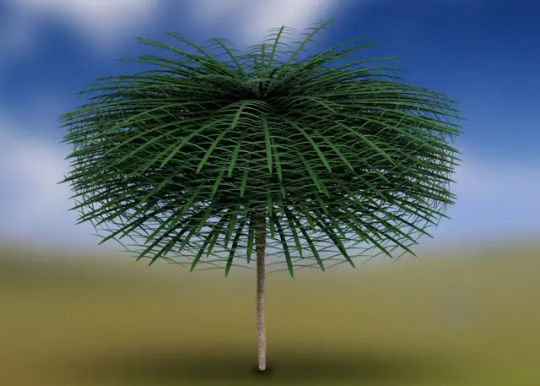

Ancient earthquake burial
The researchers excavated the first fossil tree about seven years ago, but it took another few years before four more specimens of the same plant were found in close proximity to one another. Dubbed “Sanfordiacaulis,” the newly identified species was named in honor of Laurie Sanford, the owner of the quarry where the trees were unearthed.
The forms taken by these previously unknown 350 million-year-old plants look somewhat like a modern-day fern or palm, per the study, despite the fact that those tree species didn’t appear until 300 million years later. But while the tops of ferns or palms as we know them boast few leaves, the most complete specimen of the newly discovered fossils has more than 250 leaves preserved around its trunk, with each partially preserved leaf extending around 5.7 feet (1.7 meters).
That fossil is encased in a sandstone boulder and roughly the size of a small car, according to Stimson, an assistant curator of geology and paleontology at the New Brunswick Museum.
The unique fossilization of the cluster of trees is likely due to a “catastrophic” earthquake-induced landslide that took place in an ancient rift lake, he said.
“These trees were alive when the earthquake happened. They were buried very quickly, very rapidly after that, at the bottom of the lake, and then the lake (went) back to normal,” Stimson said.
Finding complete fossil trees is rare and much less common than finding a complete dinosaur, according to Peter Wilf, a professor of geosciences and paleobotanist at Pennsylvania State University who was not involved with the study. Wilf noted via email that the “unusual” new fossil tree was a relic of a time period from which there are almost no tree fossils.
“The new fossils are a milestone in our understanding of how early forest structure evolved, eventually leading to the complex rainforest architectures that support most of Earth’s living biodiversity,” Wilf added.

‘Very Dr. Seuss’
To King, a research associate at the New Brunswick Museum who found the group of fossils, the Sanfordiacaulis would have looked like something plucked straight out of Dr. Seuss’ most popular works.
“You know in ‘The Lorax,’ the trees have these big pom-poms at the top and narrow trunks? These probably have a similar structure. You have this massive crown at the top, and then it does narrow and paper into this very small trunk,” King said. “It’s a very Dr. Seuss-looking tree. It’s a weird and wonderful idea of what this thing could look like.”
But the reign of the Sanfordiacaulis was short-lived, the researchers said. “We do not see this architecture of plant again,” Stimson said. He noted that it grew in the early Carboniferous, a time period at the end of the Paleozoic Era when plants and animals were diversifying as they started to make their way from water to land.
Much of evolution is experimental, with success often measured by a species’ versatility, or ability to adapt to many different places and conditions. The peculiar set of tree fossils presents proof of a “failed experiment of science and evolution,” Stimson added. “We’re really starting to paint that picture as to what life was like 350 million years ago.”
Looking forward
Fossils such as the Sanfordiacaulis are not just useful in helping humans understand how life changed in the past, they can help scientists figure out where life on our planet might be headed next.
The existence of this particular species suggests that trees of the period were starting to occupy different ecological niches beyond what was previously understood, according to the researchers behind its discovery.
Gastaldo sees this as an indication that plants — much like early invertebrates — were experimenting with how they adapted to the environment. The earthquake that likely led to the trees’ fossilization also offers new geological evidence of what may have been occurring in Earth’s systems at the same moment in time.
“This is really the first evidence we have of (a tree) that would be between what grows on the ground and what would tower way above the ground,” Gastaldo said. “What else was there?”
By Ayurella Horn-Muller.

#Rare 350 Million-Year-Old Tree Fossils Has Scientists ‘Gobsmacked’#New Brunswick#Fossils#Tree Fossils#paleontologist#sedimentologist#geology#Sanfordiacaulis#archeology#archeolgst#history#history news#ancient history#long post#long reads
25 notes
·
View notes
Text
National Fossil: Argentina
For “season 2“ we‘re moving to South America, more precisely to Argentina, which has lots of fossils to offer.
Once again, you get to vote on which one should represent the nation. As always, it could be a fossil that is just exceptionally well preserved and beautiful, had a huge impact on paleontology and our knowledge of the past, is very common/representative of the area, is beloved and famous in the public eye, is just a very unique and interesting find, or has any other justification.
Here are the options:
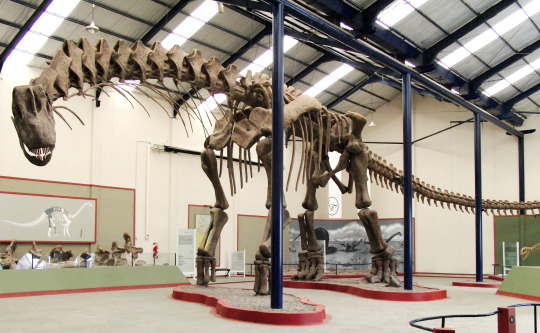
Argentinosaurus: The first contestant is one of the biggest land animals of all time with a length of more than 30 m and a weight of 80 t or more. It‘s also very fittingly named after the country.
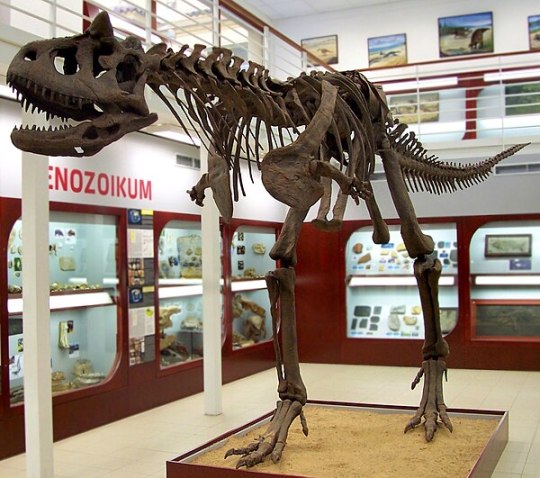
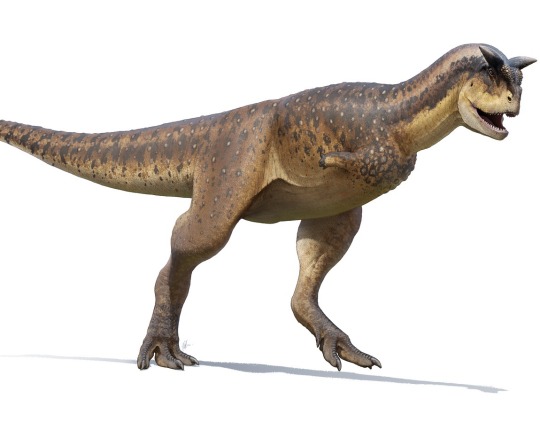
Carnotaurus: Next up is the carnivorous dinosaur Carnotaurus. Only one skeleton has ever been found, but it was so well preserved, that Carnotaurus still is one of the best understood theropod dinosaurs of the Southern hemisphere. It‘s a fan favorite movie star, with roles ranging from the dorky dancer of Prehistoric Planet all the way to the main villain of Dinsey‘s Dinosaur (Art by Fred Wierum)
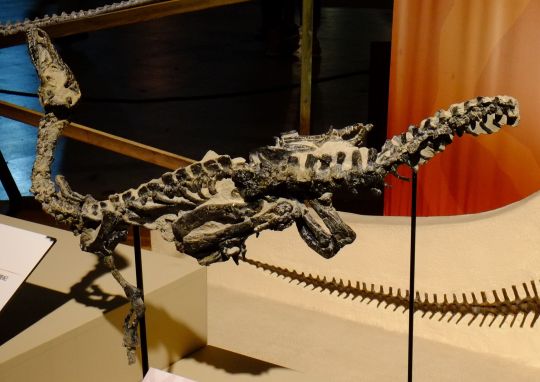
Eoraptor: while Argentina has some of the biggest dinosaurs ever to offer, it is also well known for some of the earliest ones. The small Triassic Eoraptor and some of its Argentinian cousins are very important for our understanding of the evolution of dinosaurs as a whole

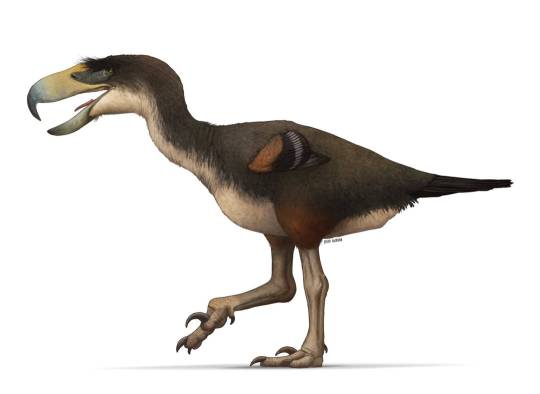
Kelenken: One of my favorite groups of South American animals are the terror birds, giant predatory flightless birds that make it very clear that birds are in fact dinosaurs. The biggest one of them was 3 m tall Kelenken, known from some leg bones and the skull. It lived during the Miocene about 15 million years ago (Art by Julio Lacerda)

Argentavis: If one giant Miocene bird is not enough for you, Argentina also offers you Argentavis. While it maybe wasn‘t the biggest flying bird in terms of wingspan, it most likely was the heaviest one (more than 70 kg; for comparison, the heaviest flying bird today weighs about 20 kg) (Art by Fabio Alejandro)

Fasolasuchus: If you‘re really not a fan of dinosaurs (including birds), maybe I can interest you in the crocodile-site of the Archosaur family tree: Fasolasuchus was an distantly-related triassic cousin of our modern crocodiles and it was the biggest terrestrial predator of its time; the only carnivores to ever surpass it were the biggest theropod dinosaurs
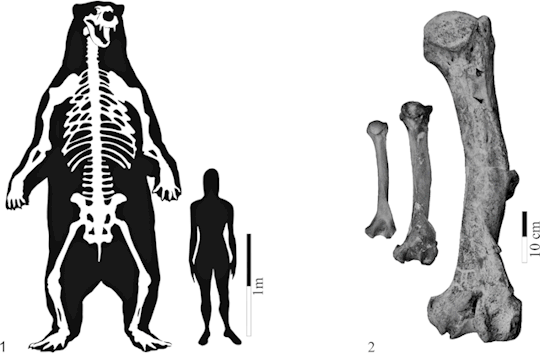
Arctotherium: South America is home to many bizarre mammals, but most of them I want to reserve for other countries. Still, here is one mammal option for y‘all: Arctotherium, the giant short-faced bear. The biggest species of them lived in Argentina and they were probably the biggest bear ever (maybe up to 1500 kg and more). (Illustration by Soibelzon, Schubert 2011)
#paleontology#paleoblr#fossils#argentinosaurus#carnotaurus#terror bird#argentavis#fasolasuchus#arctotherium
49 notes
·
View notes
Text

New SpaceTime out Monday....
SpaceTime 20240408 Series 27 Episode 43
Discovery of the faintest known star system orbiting the Milky Way
Astronomers have detected an ancient star system traveling around our Milky Way galaxy which has set a new record as the faintest and lowest-mass satellite galaxy ever discovered.
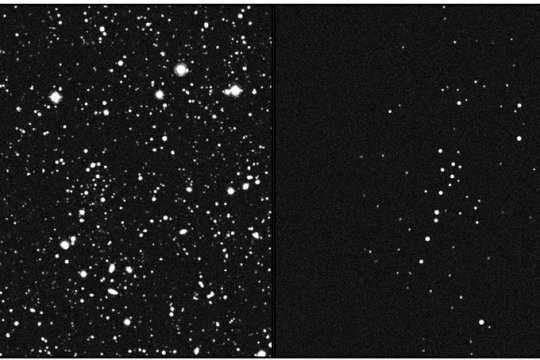
Bowen Orbital Spaceport open for business
Australia’s first privately operated orbital launch facility has been formally opened at Abbot Point near Bowen on the Queensland tropical Pacific coast. The complex is expected to undertake its first launch next month with a Gilmour Space Eris rocket to fly on its maiden flight.


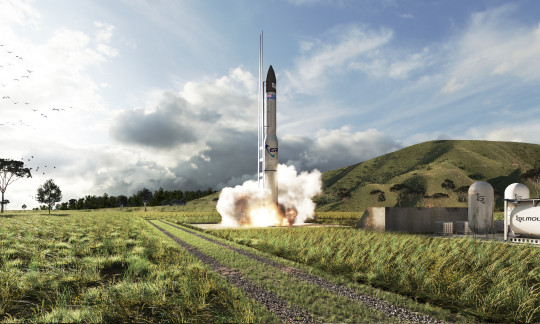


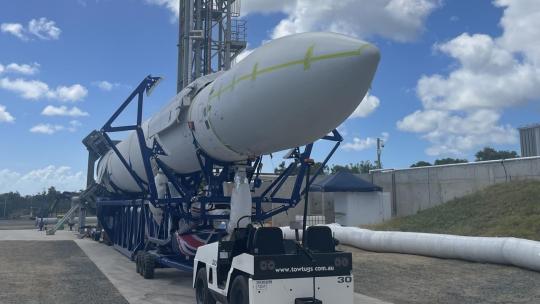





Southern launch getting ready for its next test flight
Southern Launch says its Koonibba Test Range on South Australia’s Eyre peninsula is almost ready for its next test launch in just a matter of weeks.

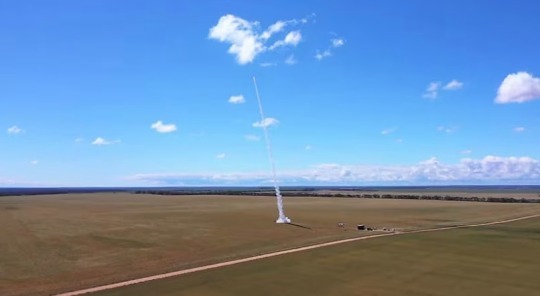
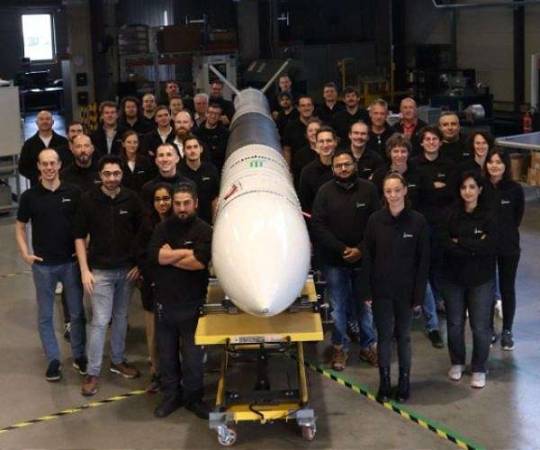
The Science Report
Warnings that Australia could soon see megadroughts lasting over twenty years.
Discovery of a strong link between Alzheimer's and the daily consumption of meat and processed foods.
A new study claims the earliest dinosaurs experienced rapid growth rates.
Skeptics guide belief in psychic powers
SpaceTime covers the latest news in astronomy & space sciences.
The show is available every Monday, Wednesday and Friday through Apple Podcasts (itunes), Stitcher, Google Podcast, Pocketcasts, SoundCloud, Bitez.com, YouTube, your favourite podcast download provider, and from www.spacetimewithstuartgary.com
SpaceTime is also broadcast through the National Science Foundation on Science Zone Radio and on both i-heart Radio and Tune-In Radio.
SpaceTime daily news blog: http://spacetimewithstuartgary.tumblr.com/
SpaceTime facebook: www.facebook.com/spacetimewithstuartgary
SpaceTime Instagram @spacetimewithstuartgary
SpaceTime twitter feed @stuartgary
SpaceTime YouTube: @SpaceTimewithStuartGary
SpaceTime -- A brief history
SpaceTime is Australia’s most popular and respected astronomy and space science news program – averaging over two million downloads every year. We’re also number five in the United States. The show reports on the latest stories and discoveries making news in astronomy, space flight, and science. SpaceTime features weekly interviews with leading Australian scientists about their research. The show began life in 1995 as ‘StarStuff’ on the Australian Broadcasting Corporation’s (ABC) NewsRadio network. Award winning investigative reporter Stuart Gary created the program during more than fifteen years as NewsRadio’s evening anchor and Science Editor. Gary’s always loved science. He studied astronomy at university and was invited to undertake a PHD in astrophysics, but instead focused on his career in journalism and radio broadcasting. He worked as an announcer and music DJ in commercial radio, before becoming a journalist and eventually joining ABC News and Current Affairs. Later, Gary became part of the team that set up ABC NewsRadio and was one of its first presenters. When asked to put his science background to use, Gary developed StarStuff which he wrote, produced and hosted, consistently achieving 9 per cent of the national Australian radio audience based on the ABC’s Nielsen ratings survey figures for the five major Australian metro markets: Sydney, Melbourne, Brisbane, Adelaide, and Perth. The StarStuff podcast was published on line by ABC Science -- achieving over 1.3 million downloads annually. However, after some 20 years, the show finally wrapped up in December 2015 following ABC funding cuts, and a redirection of available finances to increase sports and horse racing coverage. Rather than continue with the ABC, Gary resigned so that he could keep the show going independently. StarStuff was rebranded as “SpaceTime”, with the first episode being broadcast in February 2016. Over the years, SpaceTime has grown, more than doubling its former ABC audience numbers and expanding to include new segments such as the Science Report -- which provides a wrap of general science news, weekly skeptical science features, special reports looking at the latest computer and technology news, and Skywatch – which provides a monthly guide to the night skies. The show is published three times weekly (every Monday, Wednesday and Friday) and available from the United States National Science Foundation on Science Zone Radio, and through both i-heart Radio and Tune-In Radio.
#science#space#astronomy#physics#news#nasa#esa#astrophysics#spacetimewithstuartgary#starstuff#spacetime#galaxy#nasa photos#jwst
14 notes
·
View notes
Text
I really really need to practice my paleoart so I'm gonna try Archovember. (List of day prompts by @saritawolff is under the cut!) Day 1 is your choice, so I chose the leggiest of boys, Terrestrisuchus gracilis! Ignore the goofy eye, its been a while since I tried traditional art and I got too excited to erase the sketch lines and smudged it ;-;

T. gracilis lived during the Upper Triassic period, and contrary to its rather dinosaur-like appearance, it is actually one of the earliest known crocodylomorphs! Some estimates have it at about 1 meter (3 ft) long. It had long, thin legs and a thin frame. Its head was long and slender- perfect for catching tasty bugs! There seems to still be discourse over if it was a quadruped, a biped, or a mix of both (think like hadrosaurs!).


23 notes
·
View notes
Text
nothing like being asked to take my hat off indoors. listen, buddy. the earth is a rock orbiting the sun. it's one of many rocks and assorted non-rocky planets orbiting the sun in something called the solar system. the sun with its solar system is one of several hundred billion stars in the milky way galaxy. the milky way, the andromeda galaxy, and the triangulum galaxy together form the local group (along with their many satellite galaxies). the exact number of galaxies in the local group beyond the 3 largest is unknown, but estimates range from 50 to 80. the local group is part of the virgo supercluster, a concentration of at least 100 galaxy groups. the virgo supercluster, however, is actually just a subpart of the laniakea supercluster, as defined in 2014. the laniakea supercluster is home to approximately 100,000 - 150,000 galaxies, each containing billions of stars with their own planetary systems. the laniakea supercluster spans 160 megaparsecs, or 520,000,000 light years. (one light year equals 9,460,730,472,580.8 km, or 5.88 trillion miles.) the laniakea supercluster is located in the pisces–cetus supercluster complex, a galaxy filament measuring roughly 1,000,000,000 (yes, one billion) light years in length. the number of superclusters in the observable universe is estimated to be 10 million, each home to its own galaxy groups and galaxies and stars and planets and rocks. but the earth is not just a rock within an inconceivably large universe. it is a rock that happens to be very wet. and the reason why the rock is wet, is that it happens to orbit its star, the sun, at the perfect distance for peak wetness.
one unfortunate day between 4.3 and 3.7 billion years ago, this very wet rock spawned microbial life. until the cambrian explosion 538,800,000 years ago, most living things were very simple organisms, but during this period, life diversified rapidly and complex organisms eventually ventured beyond the oceans. the first known footprints on land date to 530,000,000 years ago, and the earliest dinosaurs appeared 225,000,000 years ago, along with the first mammals. the last common ancestor shared by the genera homo (humans) and pan (chimpanzee and bonobo) is estimated to have lived anywhere between 13,000,000 and 5,000,000 years ago.
the earliest appearance of members of the genus homo dates back to about 2,600,000 years ago. fire was discovered 2,000,000 years ago and has been in habitual use for at least 400,000 years, although it may have begun as early as 1,000,000 years ago. the control of fire had a lasting effect on the human diet and, according to the cooking hypothesis, it was an essential element in our evolution as it led to a large increase in energy acquisition while reducing the physical challenges of eating and the amount of energy that had to be spent on digestion. it also allowed innovations in tool making and the creation of art and pottery. it even helped develop early societies. fires required organized cooperation as they had to be maintained, and they offered gathering places for increased social interaction. the use of fire extended the waking day into the evening hours and changed humans' circadian rhythms. in addition to cooked food and artificial light, fire offered protection from predatory animals and cold temperatures, allowing humans to survive in temperate regions.
neanderthals and anatomically modern humans first appeared between 300,000 and 200,000 years ago - the former in europe, and the latter in africa. about 50,000 years ago, modern humans started colonizing the other continents, eventually replacing the neanderthals and all other hominins. the domestication of dogs began around 35,000 years ago. at the end of the last ice age, around 12,000 years ago, modern humans (and their dogs) had populated nearly the entire planet. the agricultural revolution began soon after in west asia and resulted in more and more humans adopting a sedentary lifestyle in permanent settlements with increasingly complex societies. the gradual accumulation of knowledge and technology eventually culminated in the industrial revolution, which began about 250 years ago and resulted in an unprecedented rise in population growth.
between 200 and 100 years ago, the global population of humans nearly doubled – from 1,000,000,000 to 2,000,000,000. within the next 50 years it doubled again, and then again in the 50 years following that. half of the 117,000,000,000 modern humans that have ever lived, lived in the past 2,000 years. only about 9,000,000,000 people, or less than 8%, lived in the 200,000 years before the agricultural revolution – about the same number as the current living human population. 7% of all humans that have ever existed are alive today, still sharing that same rock that happens to be very wet, in that same inconceivably large universe. billions of years spent developing sentience and sapience, on a very wet rock in a very large universe, and you're worried about the fabric covering my skull? take a step back and reassess the situation maybe
#anyway this is the shitpoast in question#recovered from my drafts#with paragraph breaks because tumblr hated my vision of one uninterrupted wall of text#🙄#i wanted you guys to shit your pance at the sight of this thing#alas#another dream destroyed#&#also#if you're reading this im sorry#you are here paying rent -> 🌍
14 notes
·
View notes
Note
What's the earliest known *definitive* dinosaur?
Currently, that would be Staurikosaurus!

Staurikosauus is from the Lower Santa Maria Formation, and has been dated to 233.23 million years old, making in about 1.5 million years older than other very early dinosaurs like Eoraptor and Herrerasaurus from the Ischigualasto Formation!
However, if we want to delve into questionable dinosaurs, there's a genus named Nyasasaurus that is known from very fragmentary remains, and may or may not be a dinosaur!
Nyasasaurus is from the Manda Formation in Tanzania, which seems to have been roughly 235-240 million years old, although dating is a bit shaky with this one. If Nyasasaurus is really a dinosaur it would be the oldest known, but again we don't have enough of the skeleton to be sure! The Wikipedia reconstruction of it literally looks like this, to give you an idea of how uncertain its anatomy is:
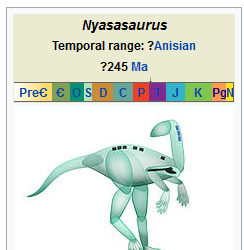
#dinosaurs#paleontology#paleoart#my art#staurikosaurus#nyasasaurus#early dinosaurs#fossils#prehisoric#palaeoblr
357 notes
·
View notes
Text
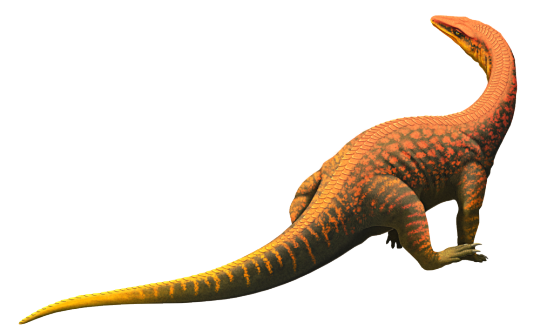
Mambachiton fiandohana lived during the mid-Triassic, about 237 million years ago, in what is now Madagascar – which at the time wasn't yet an island, still being connected to both east Africa and India as part of southern Pangaea.
It represents the earliest known branch of the avemetatarsalians, or "bird-line archosaurs", a major group of the archosaur reptiles that also includes pterosaurs and dinosaurs/birds.
It's only known from a few fragments but it was probably around 2m long (~6'6"), and would have been a carnivorous lizard-like animal with a long neck and semi-erect quadrupedal limb posture.
Unexpectedly for a bird-line archosaur it also had a staggered double row of bony osteoderms along its back, suggesting that the very earliest avemetatarsalians had some crocodilian-like armor. This seem to have very quickly been lost, though – there's no sign of osteoderms in the next branches to split off after Mambachiton, the aphanosaurs and pterosauromorphs – and although they occur again later in one dinosauriform and various non-avian dinosaurs, this appears to be multiple cases of independent re-evolution rather than retaining the original ancestral trait.
—
NixIllustration.com | Tumblr | Patreon
#science illustration#paleontology#paleoart#palaeoblr#mambachiton#avemetatarsalia#archosaur#reptile#art#there's some sparse fuzz if you look closely
306 notes
·
View notes
Text
Fossil Novembirb 4: The Megafowl

By @thewoodparable
One of the *most* iconic dinosaurs of the Cenozoic has got to be Gastornis, often referred to as "Diatryma", the giant fowl of the Early Paleogene. This animal first appeared between 60 and 56 million years ago in Europe, and spread to Asia and North America during the earliest Eocene. In the hot temperatures of the Paleocene-Eocene Thermal Maximum, it even lived up in the Arctic Circle, in the Tropical Polar Forests of the period. This single genus lasted a while, living until the middle Eocene, around 45 million years ago.
Gastornis is most famous due to its size, growing as tall as 2 meters height and up to 175 kilograms in mass. This made it one of the largest birds known, with a giant head and extremely tall beak. The skull itself was very powerfully built, with the beak compressed and lacking the raptorial hook of the later appearing terror birds.
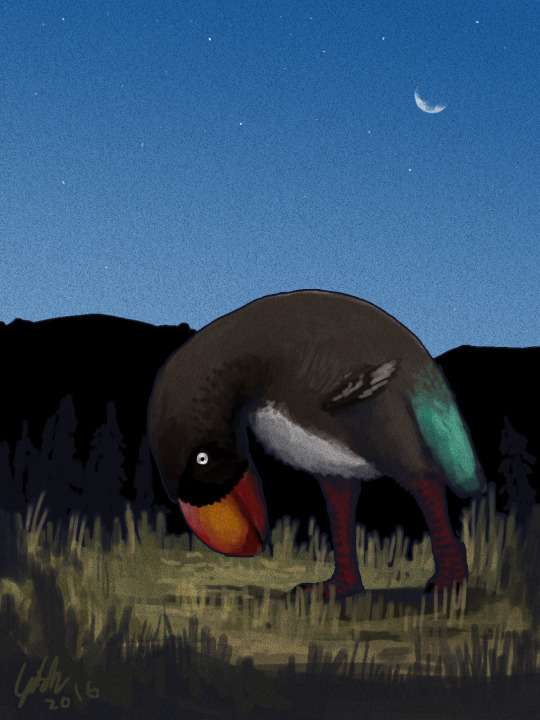
By Ashley Patch
This is important to note, because for a long time - until 2014, really - we thought Gastornis was a predator. Turns out, however, it was an herbivore, probably feeding on a generalistic diet of plants similar to other macroherbivorous dinosaurs. In fact, not only did it not have a predatory beak, but footprints that are probably from Gastornis suggest it did not have talons or raptorial feet adapted for hunting, either.
Feathers of Gastornis are not definitively known, however, a feather impression from the Green River Formation may be that of Gastornis due to its large size, and resembled feathers found on flighted birds, rather than the shaggy feathers of ratites. This is notable, as it seems that Gastornis was closely related to the "Fowl", aka Galloanserae, rather than the modern flightless ratites of today. Whether it's closer to ducks or to chickens is a question, hence the generic moniker of "Megafowl".
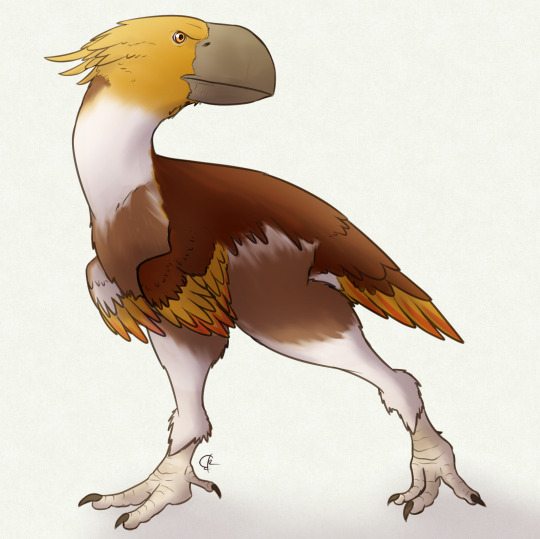
By @quetzalpali-art
Why did Gastornis go extinct? The answer is unclear. It seemed to have disappeared from North America and Asia at the end of the early Eocene, possibly due to the dropping temperatures. It persisted in Europe for longer, which was isolated at the time and may have thus been more habitable for Gastornis. That said, there is some evidence that the Mihirungs of Australia - who we'll get to know later - are related to Gastornis, and they are found in the Oligocene to Pleistocene of Australia - so maybe Gastornis didn't go away quite as soon as we thought!
Unfortunately, the behavior of this dinosaur is not particularly well known - it's uncertain if it lived in groups, how it nested, or what its foraging method would have been, as there are no living animals similar to it. Hopefully, more fossils of Gastornis will paint a clearer picture of the Megafowl of the Paleogene.
Sources:
Mayr, 2022. Paleogene Fossil Birds, 2nd Edition. Springer Cham.
Mayr, 2017. Avian Evolution: The Fossil Record of Birds and its Paleobiological Significance (TOPA Topics in Paleobiology). Wiley Blackwell.
179 notes
·
View notes
Text
I see in fiction a lot of aliens portrayed as bipedal and upright, much like humans. I wanna quickly complain about that while also explaining the insane rarity of upright bipedalism in nature. This post will be uncharacteristically long, but bear with me. Or don’t. That’s cool too.
So first of all, having 4-limbs is only really seen in the clade Tetrapoda, which includes all land vertebrates descended from our original 4-limbed ancestor. There may be a few exceptions, but most of not all 4-limbed creatures belong to Tetrapoda. So this condition is prevalent among one single group of vertebrates, which in turn are but a single group of the phylum Chordata, which is one of many phyla in the kingdom Animalia.
Now I’m exaggerating the rarity of 4-limbed creatures a bit, and it could be that 4 limbs is a common feature among land animals across the universe, but since 4 limbs are necessary for this form of bipedalism, I figured it was worth mentioning.
Second, many bipedal animals have existed in the past. The earliest known bipedal animal is a Permian bolosaurid called Eudibamus. Dinosaurs would later evolve this feature which became shared among all therapod dinosaurs, including modern birds. But this bipedalism was different, a more hunched over form which required a muscular tail to balance the center of mass over the legs.
Humans are bipedal to free up our hands for manipulation of our environment. It’s also useful for tool use, as an upright posture is perfect for spear throwing. But other intelligent animals don’t have this posture. Corvids are intelligent to use tools, and can use their beaks to handle objects. Elephants can use their trunks for all kinds of things. Humans are literally the only known species in the past half a billion years to evolve this stance.
Ok rant over.
28 notes
·
View notes
Text
Vectidromeus insularis Longrich et al., 2023 (new genus and species)

(Type specimen of Vectidromeus insularis [scale bar = 50 mm], from Longrich et al., 2023)
Meaning of name: Vectidromeus = Isle of Wight runner [in Greek]; insularis = insular [in Latin]
Age: Early Cretaceous (Barremian or possibly Hauterivian)
Where found: Wessex Formation, Isle of Wight, U.K.
How much is known: Partial skeleton of one individual including most of the hips, parts of the hindlimbs, and several tail vertebrae.
Notes: Vectidromeus was an ornithopod, a diverse group of plant-eating dinosaurs that includes the duck-billed hadrosaurids. Although hadrosaurids included the largest known ornithischian ("bird-hipped") dinosaurs and probably spent most of their time on all fours, the earliest ornithopods were small, bipedal forms, and it was this ancestral body plan that was retained by Vectidromeus.
The type specimen of Vectidromeus was probably a juvenile at the time of its death. In some ways, it resembles another small ornithopod from a slightly younger part of the Wessex Formation, Hypsilophodon. However, it differs from Hypsilophodon specimens at a similar growth stage in the shape of its hip bones, leading its describers to consider it a new species.
Reference: Longrich, N.R., D.M. Martill, M. Munt, M. Green, M. Penn, and S. Smith. 2023. Vectidromeus insularis, a new hypsilophodontid dinosaur from the Lower Cretaceous Wessex Formation of the Isle of Wight, England. Cretaceous Research advance online publication. doi: 10.1016/j.cretres.2023.105707
38 notes
·
View notes